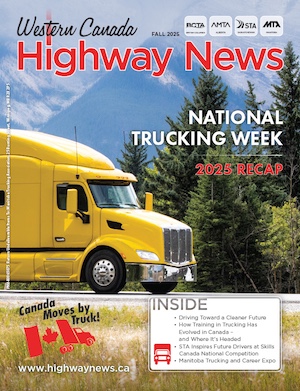The Canadian Trucking Alliance (CTA), Canada’s national trucking group, in conjunction with the provincial trucking associations, launched National Trucking Week many years ago. It begins on the first Sunday in September and runs to the following Saturday.
The purpose of the weeklong celebration is to recognize the important contributions made by the 400,000+ Canadian men and women who keep the country’s freight moving.
Provincial trucking associations, carriers, industry suppliers, regulators and other stakeholders undertake activities in their own province to mark the event. In previous years, provincial associations have marked the occasion with newspaper supplements, radio advertising, contests, special promotions, and special events at truck stops and roadside inspection stations. Carriers and industry suppliers have hosted BBQs, breakfasts, truck washes, offered special giveaways to employees and marked the week event with a wide variety of activities.
Canada moves by truck
Highlights:
The following statistics on the trucking industry have been sourced through Transport Canada‘s annual report – Transportation in Canada 2006.
Industry Performance:
• As a whole, the trucking industry (including for-hire carriers, private carriers, owner-operators and courier firms) generated an estimated
$67 billion in revenues in 2005.
• With respect to trucking firms, in 2005, general freight carriers accounted for 60% of the for-hire revenues of the industry.
• Truck carriers with annual revenues of $12 million or more accounted for 55.2% of the trucking activity.
• Heavy trucks accounted for 21.5 billion vehicle-kilometres in 2005, compared with six billion vehicle-kilometres for medium-sized trucks.
• Empty haul movements accounted
for 13% of heavy truck vehicle-kilometres in 2005, compared with about 5% for medium-sized trucks.
Infrastructure:
• The reported sales of Class 8 trucks (trucks with a gross weight exceeding 15,000 kilograms) reached a record in 2006, with sales of 39,131 vehicles.
• According to the Canadian Vehicle Survey, there were 615,000 (in scope) heavy trucks (gross weight of at least 4,500 kilograms) in Canada, of which 321,000 were medium-sized, weighing between 4,500 and
15,000 kilograms. A total of 294,000 were Class 8 (heavy) trucks.
• Ontario (37%), Alberta (25%) and Quebec (13.5%) accounted for over 75% of the heavy truck fleet.
Trade:
• Canadian for-hire trucking firms carried over 80% of total tonnage shipped intraprovincially.
• In terms of value, trucking accounted
for 61% of trade with the United States, rail 17%, pipeline 13%, air 5% and marine 4%.
• In 2006, the exports from Canada shipped by trucks totalled $185.8 billion (50.7% of total exports) down from $188.4 billion in 2005. Imports from the United States shipped by trucks amounted to $166 billion in 2006 (76.7% of total imports), up from $164.7 billion in 2005.
• In domestic activities, construction materials are the top commodities moved by trucks intraprovincially, followed by agricultural products, primary metals, metal and mineral products, and energy products.
• The main interprovincial trucking
flow was the Quebec–Ontario route
(both directions), which accounted for $40.4 billion worth of commodities, or 28% of the total interprovincial trade.
• Five commodity groups represented almost 80% of total exports in 2005: automobiles and transport equipment, machinery and electrical equipment, other manufacturing products, plastics and chemical products, and base metals/articles of base metal. The same five commodity groups represented 87% of imports.
The Border:
• The busiest transborder trucking
routes were Ontario–US central
region, Ontario–US south region
and Ontario–US northeast region. Combined, they accounted for almost 80% of the shipments.
Environment:
• On average, heavy trucks were driven 73,000 kilometres per year, about four times as much as medium trucks, which were driven 19,000 kilometres pre year.
• Heavy truck fuel efficiency averaged about 33 L/100 km, with straight trucks averaging 31 L/100 km and tractor-trailers averaging 35 L/100 km.
Labour:
• The trucking industry as a whole employed 356,124 people in 2005.
• Of these there were 109,284 drivers employed by the for-hire trucking industry, 78,500 owner-operators, and, according to 2001 census data,
102,509 self-declared delivery drivers.
(Source: © 2012, Canadian Trucking Alliance)


 1-866-985-9791
1-866-985-9791



